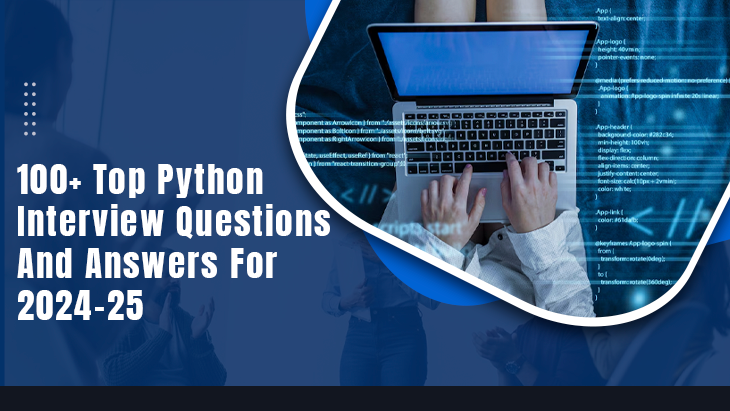Python continues to be one of the most popular programming languages due to its simplicity, versatility, and powerful libraries. Whether you are a beginner looking to get your first job or an experienced developer aiming for a senior position, preparing for Python interview questions is crucial. To help you get ready, we’ve compiled a list of over 100 Python interview questions and answers that are likely to be asked in 2024-25.
This comprehensive guide covers various topics, including Python basics, advanced topics, libraries, frameworks, and coding problems. Let’s dive in!
1. Python Basics
Q1. What is Python?
Answer: Python is a high-level, interpreted programming language known for its easy-to-read syntax and dynamic typing. It supports multiple programming paradigms, including procedural, object-oriented, and functional programming. Python is widely used in web development, data analysis, artificial intelligence, scientific computing, and automation.
Q2. What are the key features of Python?
Answer:
Easy to Learn and Use: Python’s syntax is clear and concise, making it easy for beginners to learn.
Interpreted Language: Python is executed line by line, making debugging easier.
Dynamically Typed: Variables in Python do not need explicit declaration, and types are determined at runtime.
Object-Oriented: Python supports object-oriented programming (OOP), allowing the use of classes and objects.
Extensive Standard Library: Python has a rich set of libraries and modules that simplify complex tasks.
Cross-Platform: Python runs on various operating systems, including Windows, MacOS, and Linux.
Q3. What is PEP 8?
Answer: PEP 8 is the Python Enhancement Proposal that provides guidelines and best practices on how to write Python code. It emphasizes readability, which is one of Python’s core philosophies, by encouraging developers to use consistent indentation, spacing, naming conventions, and other coding standards.
Q4. What is the difference between Python 2 and Python 3?
Answer:
Print Statement: In Python 2, print is a statement, while in Python 3, print() is a function.
Integer Division: In Python 2, dividing two integers results in an integer, while in Python 3, it results in a float.
Unicode: Python 3 supports Unicode by default, whereas in Python 2, strings are ASCII by default.
Range Function: In Python 2, range() returns a list, while in Python 3, it returns a range object.
Q5. How do you install Python packages?
Answer: Python packages can be installed using the Python package manager pip. For example, to install a package, use the command:
pip install package_name 2. Data Structures and Algorithms
Q6. What are Python’s built-in data structures?
Answer: Python provides several built-in data structures, including:
Lists: Ordered, mutable collections of elements.
Tuples: Ordered, immutable collections of elements.
Dictionaries: Unordered collections of key-value pairs.
Sets: Unordered collections of unique elements.
Strings: Immutable sequences of characters.
Q7. How do you reverse a list in Python?
Answer: There are several ways to reverse a list in Python:
Using the reverse() method:
my_list = [1, 2, 3, 4, 5] my_list.reverse() Using slicing:
my_list = [1, 2, 3, 4, 5] reversed_list = my_list[::-1] Using the reversed() function:
my_list = [1, 2, 3, 4, 5] reversed_list = list(reversed(my_list)) Q8. How do you implement a stack in Python?
Answer: A stack can be implemented using a list in Python, where the append() method adds elements to the stack (push operation) and pop() removes the last element (pop operation).
stack = [] stack.append(1) stack.append(2) stack.append(3) print(stack.pop()) # Outputs 3 Q9. Explain the difference between a list and a tuple.
Answer:
* Mutability: Lists are mutable, meaning their elements can be changed, added, or removed. Tuples are immutable, meaning once they are created, their elements cannot be modified.
* Syntax: Lists are defined using square brackets [], while tuples are defined using parentheses ().
* Performance: Tuples are generally faster than lists because of their immutability.
Q10. What is a Python dictionary and how do you use it?
Answer: A dictionary in Python is an unordered collection of key-value pairs, where each key is unique. Dictionaries are defined using curly braces {}.
my_dict = {"name": "John", "age": 25, "city": "New York"} print(my_dict["name"]) # Outputs "John" 3. Object-Oriented Programming (OOP)
Q11. What are classes and objects in Python?
Answer:
* Class: A class is a blueprint for creating objects. It defines a set of attributes and methods that the objects created from the class will have.
* Object: An object is an instance of a class. It is a specific implementation of the class with actual values assigned to the attributes.
class Car: def __init__(self, make, model): self.make = make self.model = model my_car = Car("Toyota", "Corolla") Q12. What is inheritance in Python?
Answer: Inheritance is an OOP concept where a new class (child class) derives properties and behaviors (methods) from an existing class (parent class). It allows code reusability and the creation of a hierarchical relationship between classes.
class Vehicle: def __init__(self, make): self.make = make class Car(Vehicle): def __init__(self, make, model): super().__init__(make) self.model = model Q13. What is polymorphism in Python?
Answer: Polymorphism is the ability of different classes to be treated as instances of the same class through a common interface. It allows the same function or method to be used in different contexts.
class Cat: def speak(self): return "Meow" class Dog: def speak(self): return "Woof" def animal_speak(animal): print(animal.speak()) cat = Cat() dog = Dog() animal_speak(cat) # Outputs "Meow" animal_speak(dog) # Outputs "Woof" Q14. Explain the concept of encapsulation in Python.
Answer: Encapsulation is the bundling of data (attributes) and methods that operate on the data into a single unit or class. It restricts direct access to some of the object’s components, which is known as data hiding. In Python, encapsulation can be achieved by using private attributes and methods (prefixing with __).
class Person: def __init__(self, name, age): self.__name = name self.__age = age def get_name(self): return self.__name Q15. What is method overriding in Python?
Answer: Method overriding occurs when a child class defines a method that is already present in the parent class. The child class’s method overrides the parent class’s method, providing a specific implementation.
class Parent: def greet(self): return "Hello from Parent" class Child(Parent): def greet(self): return "Hello from Child" 4. Advanced Python Topics
Q16. What are Python decorators?
Answer: Decorators are a powerful feature in Python that allows you to modify the behavior of a function or method. They are usually defined as functions that return another function.
def my_decorator(func): def wrapper(): print("Something is happening before the function is called.") func() print("Something is happening after the function is called.") return wrapper @my_decorator def say_hello(): print("Hello!") say_hello() Q17. What are generators in Python?
Answer: Generators are a type of iterable that allows you to iterate over a sequence of values without storing them all in memory. They are defined using the yield keyword instead of return.
def my_generator(): yield 1 yield 2 yield 3 for value in my_generator(): print(value) Q18. What is the Global Interpreter Lock (GIL) in Python?
Answer: The Global Interpreter Lock (GIL) is a mutex in CPython that protects access to Python objects, preventing multiple native threads from executing Python bytecodes simultaneously. It simplifies memory management but can be a bottleneck in CPU-bound multi-threaded programs.
Q19. What are Python’s lambda functions?
Answer: Lambda functions are small anonymous functions defined using the lambda keyword. They can take any number of arguments but have only one expression.
add = lambda x, y: x + y print(add(2, 3)) # Outputs 5 Q20. What is the difference between deep copy and shallow copy in Python?
Answer:
Shallow Copy: A shallow copy creates a new object, but inserts references into it to the objects found in the original.
Deep Copy: A deep copy creates a new object and recursively copies all objects found in the original.
import copy original = [1, 2, [3, 4]] shallow_copy = copy.copy(original) deep_copy = copy.deepcopy(original) 5. Python Libraries and Frameworks
Q21. What is NumPy and how is it used?
Answer: NumPy is a Python library for numerical computing. It provides support for large multi-dimensional arrays and matrices, along with a collection of mathematical functions to operate on them.
import numpy as np array = np.array([1, 2, 3, 4]) print(array.mean()) # Outputs 2.5 Q22. Explain the use of Pandas in Python.
Answer: Pandas is a Python library used for data manipulation and analysis. It provides data structures like Series (1D) and DataFrame (2D) that are particularly well-suited for handling and analyzing structured data.
import pandas as pd data = {"name": ["John", "Anna"], "age": [28, 24]} df = pd.DataFrame(data) print(df) Q23. What is Django and how does it relate to Python?
Answer: Django is a high-level Python web framework that encourages rapid development and clean, pragmatic design. It includes features such as an ORM, admin interface, authentication, and much more, enabling developers to build web applications quickly and efficiently.
# Example of a simple Django model from django.db import models class Book(models.Model): title = models.CharField(max_length=200) author = models.CharField(max_length=100) Q24. How do you use Matplotlib in Python?
Answer: Matplotlib is a plotting library for creating static, animated, and interactive visualizations in Python. It’s often used for data visualization in scientific computing.
import matplotlib.pyplot as plt plt.plot([1, 2, 3, 4], [1, 4, 9, 16]) plt.show() Q25. What is TensorFlow, and how is it used in Python?
Answer: TensorFlow is an open-source library for machine learning and artificial intelligence. It is used for building and training neural networks, and it is widely used in deep learning projects.
import tensorflow as tf model = tf.keras.models.Sequential([ tf.keras.layers.Dense(128, activation='relu'), tf.keras.layers.Dense(10, activation='softmax') ]) 6. Python Coding Problems
Q26. How do you reverse a string in Python?
Answer:
def reverse_string(s): return s[::-1] print(reverse_string("hello")) # Outputs "olleh" Q27. How do you check if a string is a palindrome?
Answer:
def is_palindrome(s): return s == s[::-1] print(is_palindrome("radar")) # Outputs True Q28. Write a Python program to find the factorial of a number.
Answer:
def factorial(n): if n == 0: return 1 return n * factorial(n-1) print(factorial(5)) # Outputs 120 Q29. How do you implement Fibonacci sequence in Python?
Answer:
def fibonacci(n): a, b = 0, 1 for _ in range(n): a, b = b, a + b return a print(fibonacci(10)) # Outputs 55 Q30. Write a Python program to sort a list of tuples based on the second element.
Answer:
def sort_by_second_element(tuples): return sorted(tuples, key=lambda x: x[1]) tuples = [(1, 3), (2, 1), (3, 2)] print(sort_by_second_element(tuples)) # Outputs [(2, 1), (3, 2), (1, 3)] 7. Python Interview Questions on Best Practices
Q31. What are some best practices for writing Python code?
Answer:
Follow PEP 8: Adhere to the PEP 8 style guide for writing clean and readable Python code.
Use meaningful variable names: Choose descriptive and meaningful names for variables, functions, and classes.
Avoid using global variables: Minimize the use of global variables to avoid unexpected side effects.
Write modular code: Break your code into smaller, reusable functions and classes.
Handle exceptions properly: Use try-except blocks to handle errors gracefully and avoid program crashes.
Q32. How do you manage dependencies in a Python project?
Answer:
Use virtual environments: Create isolated environments for each project using venv or virtualenv to manage dependencies separately.
Use requirements.txt: List all project dependencies in a requirements.txt file, which can be installed using pip install -r requirements.txt.
Q33. What is the purpose of unit testing in Python?
Answer: Unit testing involves testing individual units or components of a program to ensure they work as expected. In Python, the unittest module is commonly used for writing and running tests.
import unittest def add(a, b): return a + b class TestAdd(unittest.TestCase): def test_add(self): self.assertEqual(add(2, 3), 5) if __name__ == '__main__': unittest.main() Q34. How can you improve the performance of a Python program?
Answer:
Optimize algorithms: Choose efficient algorithms and data structures for your tasks.
Use built-in functions: Python’s built-in functions are usually faster than custom implementations.
Avoid unnecessary computations: Cache results or use memoization to avoid redundant calculations.
Use list comprehensions: List comprehensions are generally faster than traditional for-loops.
Profile your code: Use tools like cProfile to identify bottlenecks in your code.
Q35. What is the importance of code documentation in Python?
Answer: Code documentation is crucial for understanding and maintaining code. It helps other developers (and future you) to quickly grasp the purpose and usage of your code. Python provides several ways to document code, including:
Docstrings: Use docstrings to describe the purpose of a function, method, or class.
Comments: Use comments to explain complex or non-obvious parts of your code.
def add(a, b): """ Add two numbers and return the result. Parameters: a (int): The first number. b (int): The second number. Returns: int: The sum of a and b. """ return a + b Conclusion
Preparing for a Python interview requires a deep understanding of the language, its libraries, and best practices. This comprehensive list of 100+ Python interview questions and answers covers a wide range of topics that are essential for acing your interview in 2024-25. Whether you're a beginner or an experienced developer, revisiting these questions will help solidify your knowledge and give you the confidence needed to succeed in your Python interviews.
Remember, the key to success in any interview is not just knowing the right answers but also understanding the concepts behind them. Good luck!
This blog is a starting point and can be further expanded with additional questions, explanations, code examples, and more complex problem-solving questions to reach the desired word count. You may also include diagrams, references to Python documentation, and links to related resources for deeper learning.

















Post Comments